-
2019 SHERA Emerging Scholar Prize
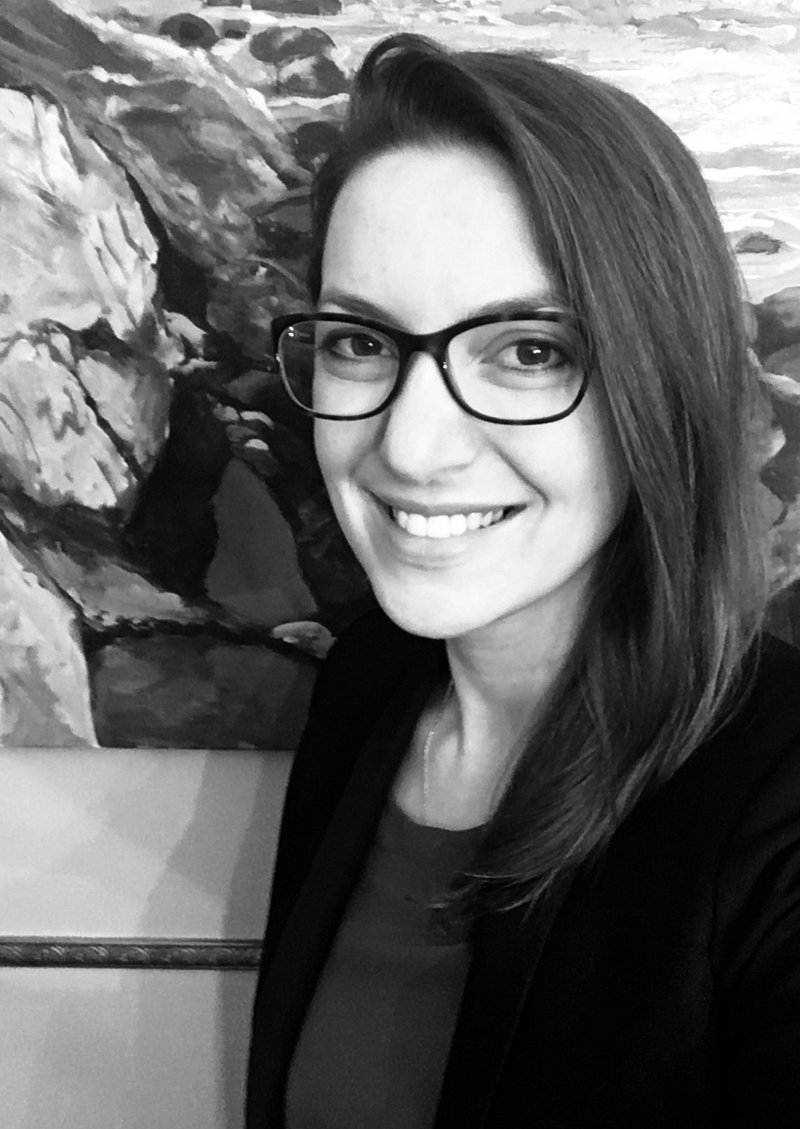
The 2019 SHERA Emerging Scholar Prize was awarded to Alice Isabella Sullivan (University of Michigan) for her article “The Athonite Patronage of Stephen III of Moldavia, 1457-1504,” Speculum 94.1 (2019): 1-46.
The jury consisted of Carolyn Guile, Colleen McQuillen, Marie-Alice L’Heureux.
Jury commendation: After contextualizing Stephen III’s activities within the mid-fourteenth-century legacy of patronage directed from within the sub-Carpathian Romanian-speaking lands, Sullivan demonstrates how the Prince’s “aspirations as a Christian ruler and protector of Orthodox faith” (8) in a kingdom perceived as a bulwark of Christianity, and his fashioning himself “an heir to the authority of Byzantine emperors among Christian peoples under Ottoman control”(4) motivated his activities as a patron of Athonite monasteries of the “Holy Mount”. The committee felt this highly original study deserves the Prize for its new and significant contribution to our understanding of not only how sacred landscapes developed within the northeastern Greek territories in the nearly fifty-year period of Stephen III’s rule, but also how princely patronage from Europe’s eastern borderlands had a direct and profound impact on the broader reification of Byzantine culture after the fall of Constantinople in 1453. Whereas previous scholarship has tended to focus on the study of Byzantine ideology in these lands (historical Wallachia, Moldavia) in the sixteenth-eighteenth centuries, Sullivan turns a conventional center-periphery argument on its head. An impressive linguistic and material array of primary sources that includes liturgical artifacts, vestments, manuscripts, buildings, inscriptions, and monetary records in Church Slavonic, Greek and Romanian underpins Sullivan’s deft elucidation of the connection between cross-cultural exchange and contemporary patronage. The committee would like to recognize and praise the intellectual work that a study of this type requires, the clarity of its presentation, and the demonstration of how the study of “borderland” territories is essential to how we interpret and theorize cross-cultural exchange.
Next Emerging Scholar Prize deadline: September 30, 2020
-
PUB: Art and Commerce in Late Imperial Russia | The Peredvizhniki, a Partnership of Artists
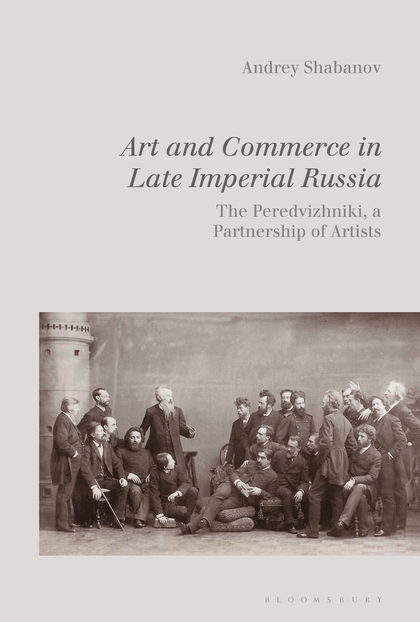
Art and Commerce in Late Imperial Russia | The Peredvizhniki, a Partnership of Artists (Bloomsbury, 2019)
By Andrey ShabanovAndrey Shabanov’s seminal reinterpretation of the Peredvizhniki is a comprehensive study that examines in-depth for the first time the organizational structure, self-representation, exhibitions, and critical reception of this 19th-century artistic partnership. Shabanov advances a more pragmatic reading of the Peredvizhniki, artists seeking professional and creative freedom in authoritarian Tsarist Russia. He likewise demonstrates and challenges how and why the group eventually came to be defined as a critically-minded Realist art movement. Unprecedentedly rich in new primary visual and textual sources, the book also connects afresh the Russian and Western art worlds of the period. A must-read for anyone interested in Russian art and culture, 19th-century European art, and also the history of art exhibitions, art movements, and the art market.
More information about the publication can be found here.
-
SHERA Business Meeting and Lunch, CAA, New York
For those attending the College Art Association Annual Conference in February, we’re looking forward to seeing you in New York! Please add to your calendars the following SHERA events:
SHERA Business Meeting, followed by lunch:
Friday, 2/15, 12:30 pm, New York Hilton Midtown - 2nd Floor - Madison Suite
We’ll hold a 20 min. business meeting at the Hilton and then adjourn for further discussion and refreshment at the Russian Samovar (256 W. 52nd St.). If you plan to join us for lunch, RSVP here.
SHERA-Affiliated Panel:
Saturday, 2/16, 2-3:30pm, New York Hilton Midtown - 2nd Floor – Gramercy West
“Looking East: Russian Orientalism in a Global Context,” organized by Maria Taroutina and Allison Leigh, with papers by Ekaterina Heath, Andrew Nedd, Katrin Kaufmann, Inessa Kouteinikova, and Marie Gasper-Hulvat.
If you’re participating in or know of a panel that might be of interest to SHERA members, please post it on H-SHERA or send the information to us at shera.artarchitecture@gmail.com so that we can compile a list and send it out before the conference.
-
Letter from Eva Forgacs, SHERA President
Dear Sheraens,
At the end of my term as President of SHERA I would like to thank all Board members for their hard work to keep our Society in good shape, increasing membership, posting our news, and contributing to making progress. Thanks go to all SHERA members for enthusiastically participating in our activities, sharing news of their work, achievements, and publications, and participate in our sponsored sessions at CAA and ASEEES. We greatly appreciate the continued support of our institutional members.
Thanks to the organizing work of Karen Kettering and the jury she recruited, we were able to establish the long-planned Emerging Scholar Essay Prize and award it in 2017 and 2018. We owe thanks to the anonymous donor who made it possible for us to award a SHERA Travel Grant for a confirmed speaker to facilitate attendance of CAA or ASEEES respectively in alternating years.
It would have been very difficult to oversee our activities without the continued counseling and attention of former Presidents Margaret Samu and Natasha Kurchanova.
It has been an honor for me to serve and I am confident that SHERA continues to make further progress under the guardianship of our new President and the continuing service of our Officers.
I wish a Happy Holiday Season to all of you and look forward to meeting up at our SHERA-sponsored sessions and other venues.
With Greetings to All, Eva Forgacs
-
SHERA Graduate Student / Independent Scholar Travel Grant
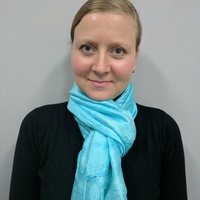
The SHERA board is pleased to announce that Dr. Ekaterina Heath of the University of Sydney has been selected as the recipient of the SHERA Graduate Student / Independent Scholar Travel Grant for CAA 2019. She will deliver her paper entitled “Picturing the Cathay in Russia: Political use of Chinoiserie interiors under Empress Elisabeth Petrovna and Emperor Peter III” in the panel “Looking East: Russian Orientalism in a Global Context.” For more details see CAA’s webpage.
-
OPP: SHERA-sponsored panel at ASEEES 2019 (Deadline February 1, 2019)
SHERA-sponsored panel at ASEEES 2019 (Deadline February 1, 2019)
The SHERA Board invites proposals for the Society’s sponsored panel at the 2019 ASEEES Annual Conference. The conference will be held in San Francisco from November 23 to 26, 2019 and the theme is “Belief.” More information on the convention theme can be found here. As an affiliated society, SHERA may submit one sponsored panel. This session has guaranteed acceptance from ASEEES and will be identified as an Affiliated Society session in all ASEEES conference schedules (printed, online, and in the conference app).
Proposed panels must focus on issues of art, architecture, visual culture, or any of the fields concerning SHERA as a Society.
All members of the proposed panel must be members of ASEEES and SHERA in good standing and must register for the conference. Please submit:
- Title and a brief description of the panel (no more than 250 words)
- Names of all panel members, including chair and discussants, and a brief CV (no more than two pages) for each
- Brief descriptions of each paper (no more than 250 words)
Proposals should be sent to shera.artarchitecture@gmail.com with the subject heading “SHERA-sponsored panel at ASEEES 2019.”
Information joining SHERA can be found here. Information on joining ASEEES can be found here.
The deadline for submission of panels to ASEEES is February 15, 2019. Therefore, applications must be sent to the SHERA Board by February 1, 2019 for notification on February 10, 2019.
-
EXH: PEASANTS, CLANS, AND EFFERVESCENT ABSOLUTISTS!
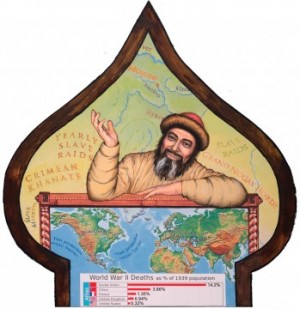
Tuesday, September 4, 2018 to Thursday, October 18, 2018 Harriman Institute Atrium, 12th Floor International Affairs Building (420 W 118th St) Exhibit runs September 4 – October 18, 2018. Exhibit hours are Monday–Friday, 9:00AM – 5:00PM excluding university holidays.
Artist Anne Bobroff-Hajal has a PhD in Russian History and is the author of the scholarly volume Working Women in Russia Under the Hunger Tsars. Her extensively researched polyptychs are satirical commentaries on how Russia’s ruling elites have historically taken advantage of their unique geographic situation to amass and maintain power. She means for her art to honor and serve the dispossessed and forgotten.
Bobroff-Hajal’s work draws formally on the similarities among icons, political cartoons, animation storyboards, and graphic novels, all of which tell stories in pictures. Her tales are told across centuries to the Infant Stalin by three tsarist godparents: Ivan IV, Catherine the Great, and Peter the Great. Each polyptych is “narrated” via the artist’s original lyrics set to the tune of Kalinka, in a series of tableaux which viewers “read” through numbered frames or simply from left to right. Bobroff-Hajal’s goal is to beguile viewers to identify and engage with forces that have shaped power structures in Russia and other parts of the world.
Intellectually, Bobroff-Hajal’s work brings together disparate fields’ analyses of Russia: historians of ideology who have observed Russian elites’ centuries-old use of the threat of invasion to unify the country behind an autocratic leader; global history scholars like Perry Anderson who wrote that “Eastern Absolutism…was the price of [Russians’] survival in a civilization of unremitting territorial warfare;” geographers who have described Russia as “the least defensible country on earth” because of its vast flatland steppes devoid of natural barriers to invasion. Putin today is only the most recent Russian ruler to manipulate threat of invasion across the plains to support extreme appropriation of wealth and power from the populace for the benefit of ruling elites.
Bobroff-Hajal’s 110-page fully illustrated catalogue is now published online, with extensive historical analysis and info about her artistic process. Please click here to access the catalogue. For best results view using the “full screen” function.
Historian J. Arch Getty wrote,
Anne Bobroff-Hajal’s art combines deep historical knowledge with humor and artistic talent that speaks to audiences ranging from school children to professors. I cannot imagine a more distinctive and iconoclastic combination. In her formidable painting of Ivan IV, his stern face conveys a series of meanings, and the postures of his underlings depict patronage and clan relationships that reflect the latest historical research on the 16th century. Her paintings of Stalin with Bolshevik patronage clans show a similar skill and informed artistry that also capture recent research. Her Catherine the Great, who ‘flies’ by means of stilt-walking serfs hoisting her and her heavy decorative gold wings, does more, and more vividly than many books on Catherine. The whimsical style of her work allows it (like icons of old) to tell stories on many levels, ranging from the nearly comic to an accomplished complexity. Her work is truly unique and deserves a wide audience.
From the artist:
“I’ve been asked how I can bear to spend so much time painting brutality and horrors. I do it because art—with its color, beauty, satire, story, whimsy—is the tool we humans have to lift us from despair as we investigate the sources of atrocities so as to combat them in the future.
How do elites—not only in Russia, but the world over—amass the power to do such terrible things to less powerful people? What are the resources rulers use to accumulate power? How do they exploit those resources to maintain their omnipotence? How have some some regions of the world been able to wield dominion over other regions?
Russian absolutism, as historian Perry Anderson observed, not only began earlier than in Europe, it “outlived all its contemporaries, to become the only Absolutist State in the continent to survive intact into the 20th century.” The 1917 collapse of the Tsarist autocracy was followed a decade after the Bolshevik Revolution by the rising Joseph Stalin’s “Communist” autocracy. That in turn collapsed in the 1990s, to be followed a decade later by the rise of a new autocrat-in-the-making, Vladimir Putin. Why do distinctive historic cycles recur in each region of the globe, and how can they be broken?
I believe that each land’s distinct geography presents singular opportunities for elites to build and sustain power. In particular, Russia is by far the planet’s largest flat landscape. Geographers have called Russia the least defensible terrain on earth because of its lack of natural barriers against hugely powerful neighbors. My art explores the web of interconnections between Russia’s unique geography—both natural and human—and its rulers, clans, and laboring classes. I paint the social system Russia’s geography gives rise to, the elites it empowers, and hundreds of tiny portraits of individual people straining to achieve their goals within that system.
It may seem obsessional to paint so many three-inch-high portraits in such a time-intensive way, often using a magnifying glass to paint each face and detail. But I create art to honor and hopefully serve the dispossessed and forgotten. My goal is for my art to delight viewers to identify forces that have shaped varying power structures in different parts of the world, in order to illuminate how they might create change within their own.”
-
CFP: Eclecticism at the Edges: Medieval Art and Architecture at the Crossroads of the Latin, Greek, and Slavic Cultural Spheres (c.1300-c.1550)
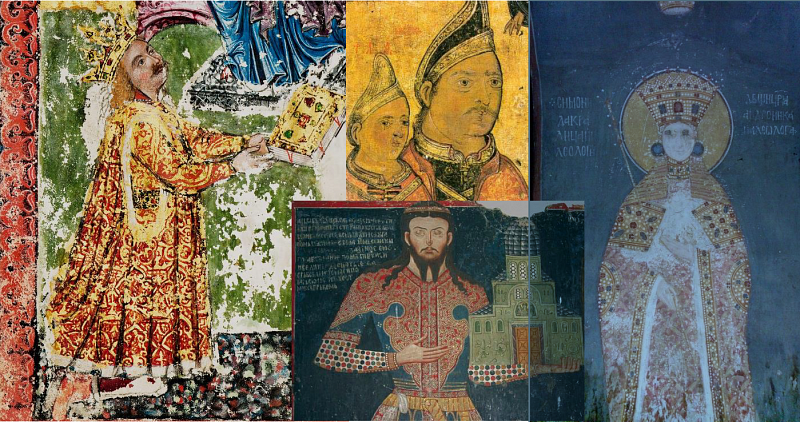
Date: April 5-6, 2019 Location: Princeton University
Organizers: Alice Isabella Sullivan, Ph.D. (University of Michigan) Maria Alessia Rossi, Ph.D. (The Index of Medieval Art, Princeton University)
Description: In response to the global turn in art history, this two-day symposium explores the temporal and geographic parameters of the study of medieval art, seeking to challenge the ways we think about the artistic production of Eastern Europe. Serbia, Bulgaria, and the Romanian principalities of Wallachia, Moldavia, and Transylvania, among other centers, took on prominent roles in the transmission and appropriation of western medieval, byzantine, and Slavic artistic traditions, as well as the continuation of the cultural legacy of Byzantium in the later centuries of the empire, and especially in the decades after the fall of Constantinople in 1453.
This symposium will be the first such initiative to explore, discuss, and focus on the art, architecture, and visual culture of regions of the Balkans and the Carpathians (c.1300-c.1550). We aim to raise issues of cultural contact, transmission, and appropriation of western medieval, byzantine, and Slavic artistic and cultural traditions in eastern European centers, and consider how this heritage was deployed to shape notions of identity and visual rhetoric in these regions from the fourteenth through the sixteenth centuries. This event will offer a comparative and multi-disciplinary framework, ranging from art history to archeology and from material culture to architectural history.
We aim to create a platform where scholars at various stages of their careers can discuss their research and engage in dialogue regarding the specificities but also the shared cultural heritage of these regions of Eastern Europe that developed eclectic visual vocabularies and formed a cultural landscape beyond medieval, byzantine, and modern borders.
Papers could address topics that include, but are not limited to: How cross-cultural contact facilitated the transfer, appropriation, and transmission of ideas and artistic traditions across geographical and temporal boundaries in Eastern Europe (c.1300-c.1550) Artistic and iconographic developments as expressions of particular social, political, and ecclesiastical circumstances and dialogues in the Balkans and the Carpathians The intentions and consequences of diplomatic missions and dynastic marriages in the visual agenda of eastern European centers Workshop practices and traveling artists beyond medieval political and religious borders Patronage and new constructs of identity before and after 1453
Interested scholars should submit a paper title, a 500-word abstract, and a CV by August 15, 2018 to the organizers at: eclecticism.symposium@gmail.com
Funds will be available to defray the cost of travel and accommodations for participants whose papers are accepted in the Symposium. So far, this event is supported in part by the International Center of Medieval Art (www.medievalart.org), the Society of Historians of East European, Eurasian, and Russian Art and Architecture (www.shera-art.org), as well as The Index of Medieval Art at Princeton University.
-
SHERA December 2017 Election Results
We are pleased to announce the results of the December 2017 SHERA elections and warmly welcome the following individuals to the SHERA Board. Congratulations! We look forward to working with you.
Members-at-large (2 year term)
Hanna Chuchvaha Nic Iljine Natalia Kolodzei Andrey Shabanov
Secretary-Treasurer (2 year term)
Alice Isabella Sullivan
Web News Editor (1 year term)
Corina L. Apostol
Thank you to the SHERA dues-paying members who voted.
Sincerely, SHERA Officers
Eva Forgacs, President Karen Kettering, Vice-President/President-Elect Ksenia Nouril, Secretary-Treasurer Yelena Kalinsky, Listserv Administrator Corina L. Apostol, Web News Editor Anna P. Sokolina, SHERA-SAH Liaison
-
SHERA: Emerging Scholar Prize Awarded

The SHERA Emerging Scholar Prize was awarded to Christina E. Crawford (Emory University) for her article “From Tractors to Territory: Socialist Urbanization through Standardization,” Journal of Urban History (January 2018).
The jury consisted of Carolyn C. Guile, Janet Kennedy, Juliet Koss, Marie Alice L’Heureux, and Colleen McQuillen.
Jury commendation: Rigorously researched and theoretically astute, Christina Crawford’s essay “From Tractors to Territory: Socialist Urbanization through Standardization” (Journal of Urban History) is the Award Committee’s unanimous choice for the First Annual SHERA Emerging Scholars’ Essay Prize. Examining the design and construction of both the Kharkiv Tractor Factory (1930-31) and the neighboring planned city for its workers, Crawford details the importation of a Fordist model of industrial standardization into a Soviet context and demonstrates how the concept of priviazka, taken from contemporaneous architectural discourse, was productively applied to other spheres in order to facilitate rapid growth in manufacturing and distribution. Her essay illuminates the importance of adaptability within the ostensibly standardized design practices that fueled the breakneck tempo of industrialization and urbanization during Stalin’s first Five-Year Plan. Innovative and authoritative, Crawford’s scholarship offers a methodological model for considering the relationship of architectural design and economic development during the process of early Soviet industrialization.
Next Emerging Scholar Prize deadline: September 30, 2018
News filed under: